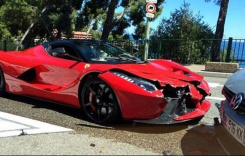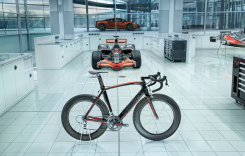“Yes, you can ride it on the highway, and yes it is plenty fast,” explained Suzuki’s media rep, former MotoUSA-scribe and AMA Superbike young gun Frankie Garcia as parts and accessories man Jeff Walters tugged the cover off the new-for-USA 200cc Burgman. The assembled moto-journalists were not too excited, jaded bunch that they are. Two hundred cc isn’t going to impress anyone in a First-World economy, and the scooter’s styling is pleasant, but probably won’t wind up in the Guggenheim.

The tech brief, held at an understated Indian-tribe-owned golf resort and Casino in El Cajon, California, was similarly modest. Garcia told us the Burgman 200 has been available in Europe for several years, and was last updated in 2007. It’s called a “super” or “maxi” scooter in Europe, where heavier scooters with more power, stowage and wind protection are prized by intercity commuters.
The Burgman 200 uses a standard tube-steel frame concealed by new, narrower bodywork, with 57.7 inches between the 13-inch front hoop and 12-inch rear. A 33mm front fork is held in place by a single triple clamp, while the rear is suspended by adjustable twin shocks. ABS-equipped disc brakes (single on the front) slow things down. The fuel tank is mounted low, under the floorboards for mass centralization, and it all weighs in at a claimed 359 pounds gassed up.
(Above) ABS comes standard and does the job well. (Below) The Burgman 200 has comprehensive instrumentation, cell-phone charger, remote seat opener, illuminated storage and multiple glove boxes.
Suzuki rates the Burgman 200 at 18 horsepower, impressive numbers for a small scooter engine. That’s thanks to liquid cooling (there’s a trick-looking aluminum radiator mounted right behind the front wheel) and a sophisticated fuel-injection system. Suzuki tells us the CVT has a fixed-spring design to “reduce the amount of imbalances while in operation and thus minimize vibration.” Garcia noted that the scooter thumps and buzzes at idle, but smoothes out when you twist the fun-tube: “you gotta give some to get some,” he said. Jeff showed off accessories, including a custom cover with enough adjustment to accommodate a top case, luggage rack and said locking top case, a taller windscreen and more. After that, it was time to catch the shuttle to the Casino and teach Garcia how to shoot craps. We won $4.
The next day it was time to do a big loop around San Diego County. Honestly, I wasn’t that excited by the tech brief, but then I rode the 200 and my opinion changed quickly. Starting the Burgman up was not as smooth an experience as some other modern gas-burning products can offer—it was a bit balky (I’d chalk it up to break-in) and cold-blooded, and like Garcia said, it did shake at idle. Warm up was quick, and soon I was riding around the parking lot, practicing U-turns and getting used to the ABS. I noticed how low the seat was and how easy the bike was to manage at low speeds, with floorboard cut-outs helping me get my feet down and making the scooter feel narrower than I expected.
None of that stuff was too surprising, but opening the throttle up a bit on the open roads of east San Diego County made me start to think this scooter was really something different. For its size, this motor rips. It does indeed smooth out past idle, and the CVT and gearing are well-selected. Passing traffic at speeds under 60 is absolutely no problem, and the fuel injection felt just right for this application.
When the going got a bit twisty, the Burgman became a Countryman. The shocks work as well as the heavy back end would let them—good job selecting spring rate, Suzuki!—and the front fork absorbed bumps and ripples just fine. The chassis felt rigid at our pace, but what really impressed me was the cornering ability of these little fellers. Frankie G could doubtless drag an elbow on the street if he wanted to, but I never saw a spark fly from any part of his Burgmans, and we were not going slow. I tried to drag the long centerstand tang or the low-mounted muffler, but no dice: if you want to see sparks, watch the first few minutes of Flashdance (yes, I know it’s an ancient reference, but Jennifer Beals welding is still hot after 30 years), as it’s pretty hard to drag anything on this scooter unless you’re crashing. And if you’re worried about small wheels, as one of the journalists confided to me before the ride, don’t—this scooter is very stable at speed and didn’t suffer over bumps, either. I don’t think you can call 13 inches small. Hey! I’m talking about tires. This is a family website.

Around town, the Burgman is light and easy to manage. It has a lot of steering lock and the weight of the bike is nice and low, so low-speed around-town maneuvers are easy. The suspension, while firm enough for sporting fun, is also compliant over a variety of surfaces. The brakes are very good, though the front lacks power. But use both firmly and you’ll be rewarded with quick stops, and the ABS adds confidence – it won’t reduce stopping distance, but it will keep you from locking up your tires or sliding in the wet. It’s the kind of thing you really should consider having if you spend a lot of time in heavy traffic or ride in all weather conditions.
When you reach your destination, the Burgman can show off some luxury touches. In addition to the comprehensive instrumentation, cell-phone charger, remote seat opener, illuminated storage and multiple glove boxes, the Burgman offers a cavern of space under the seat. You can get two full-face helmets under there with room left over for other stuff, or a few bags of groceries if you’re headed home. Sportbike guys get excited by torque curves and Öhlins suspension – scooter people like being able to carry stuff home, so by that standard the Burgman 200 is a Panigale R. It’s that exciting seeing so much room under your seat.

The Burgman 200 is an excellent general-purpose scooter with a $4999 MSRP. Honda’s PCX150 is $500 less, but it doesn’t have ABS, the giant storage capacity and it tops out at 70 mph. A better comparison would be larger-displacement scoots like the Kymco People GT300i ($5399) or the Honda Forza ($6099 with ABS) or even Vespa’s GTS300. Both of those rides offer bigger motors, but not that much more power or top speed—and they both cost more money.
So slap a “300” sticker on the side of the Burgman and it’s a good value, especially considering it comes standard with ABS. You can commute, tour, ride the twisties or haul a sack of cat litter home, and have a good time doing it – and that’s the essence of scootering. Suzuki’s entry into the middleweight scooter market is a product worthy of serious consideration, especially if you value a little more sporting ability in your scoot.









